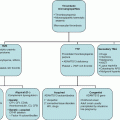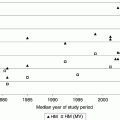Chapter 6 Stephen F. Hawkins1 and Quentin A. Hill2 1 Department of Haematology, Royal Liverpool University Hospital, Liverpool, UK 2 Department of Haematology, Leeds Teaching Hospitals NHS Trust, Leeds, UK A blood film is produced by smearing a small drop of blood on a glass slide, allowing it to dry and then applying a number of stains, which prepare it for examination by microscopy [1]. The most commonly used stain for routine blood films is May–Grünwald–Giemsa (MGG), but a number of additional stains are used in special circumstances (e.g. Giemsa at pH 7.2 for identification of malarial parasites). A blood film may be prepared by laboratory staff in response to abnormal blood count parameters. Thresholds are usually determined locally (e.g. if the platelet count is <50 or leukocyte count >20). Additionally, a film can be requested by the clinician. Consider requesting a blood film during the investigation of suspected haemolysis, haematological malignancy, unexplained high blood counts or cytopenias and persistent or relapsing fever (especially with a relevant travel history or tick exposure). Blood films also have a role in monitoring the response to treatment of thrombotic microangiopathies. The preparation of a blood film takes approximately 20 min, while the actual examination of it may take several minutes depending on the clinical scenario. It is important that the specific question being asked (e.g. ‘mitral valve replacement with paravalvular leak, haemolysis?’) is written on the request form, to ensure laboratory staff provide the most informative report. The differential diagnosis and clinical approach to high and low blood counts are discussed in Chapters 1, 2, 3 and 4. How diagnosis of blood count abnormalities or suspected infection can be aided by the blood film will now be discussed. The meaning and possible causes of common blood film abnormalities are summarized in Table 6.1. Table 6.1 Common blood film terminology.
Understanding the Blood Film
Blood film terminology
Meaning
Associated disorders
Red cells
Acanthocytes
Cells with spicules of irregular size and spacing
High numbers associated with liver disease, some neuroacanthocytosis disorders and myelodysplasia. Smaller numbers if hyposplenic, hypothyroid, starvation or anorexia
Agglutination
Red cells form clumps
Cold agglutinins (autoantibodies most active below body temperature). May cause haemolysis
Anisocytosis
Variation in size
Present in haematinic deficiency and a variety of haematological disorders
Echinocytes (crenated or burr cells)
Short regular spicules
Storage artefact, renal failure, liver disease, vitamin E or pyruvate kinase deficiency, burn injury
Elliptocytes
Red cells with an elliptical, cigar or pencil shape
Hereditary elliptocytosis. Present in smaller numbers in thalassaemia, iron deficiency, megaloblastic anaemia, myelodysplasia or myelofibrosis
Fragments (schistocytes)
Red cell fragmentation due to intravascular destruction
Microangiopathic processes, malaria, paroxysmal nocturnal haemoglobinuria, ABO–-mismatched blood transfusion
Irregularly contracted cells
Loss of central pallor, irregular shape
Disorders of haemoglobin (Hb) synthesis (e.g. Hb C, SC or H disease, β-thalassaemia trait), G6PD deficiency, drug-induced oxidative haemolysis
Macrocytic anaemia
Large red cells
Liver disease, hypothyroid, B12/folate deficiency, bleeding, haemolysis, myelodysplasia, medication, pregnancy, spurious (e.g. cold agglutinins)
Microcytic anaemia
Small red cells
Iron deficiency, thalassaemic disorders and traits, anaemia of chronic disease, sideroblastic anaemia, lead poisoning
Poikilocytosis
Variation in shape
Present in various disorders. If severe, consider myelofibrosis, hereditary pyropoikilocytosis, dyserythropoietic anaemia or storage artefact
Polychromasia
More reticulocytes: newly released red cells, larger and stain with a blue tint (higher RNA content)
Response to hypoxia, anaemia (e.g. bleeding or haemolysis) or haematinic replacement
Rouleaux
Red cells line up in stacks
Increased plasma proteins, e.g. inflammation, pregnancy
Spherocytes
Loss of membrane results in small cells without central pallor
Haemolytic conditions. Severe burns
Stomatocytes
Linear slit or mouthlike area of central pallor
Alcohol excess, chronic liver disease, chlorpromazine, inherited haemolytic conditions (e.g. hereditary stomatocytosis, cryohydrocytosis, Tangier disease). Small numbers can be normal
Target cells
An additional central area of dense staining
Liver disease, haemoglobinopathies, iron deficiency, hyposplenism
Teardrop poikilocytes (dacrocytes)
Teardrop shape
Myelofibrosis, myelodysplasia, marrow infiltration, thalassaemia, megaloblastic anaemia, some cases of acquired and Heinz body haemolytic anaemia
Red cell inclusions
Basophilic stippling
Multiple small RNA deposits
Thalassaemia (major or trait), unstable Hb, iron deficiency (small numbers), megaloblastic anaemia, myelodysplasia, myelofibrosis, lead poisoning, pyrimidine 5′-nucleotidase deficiency
Howell–Jolly bodies
A round, usually solitary inclusion that is a nuclear remnant
Normally removed by the spleen; these are found in hyposplenic states including the neonatal period
Nucleated red cells
Early red cell forms in which the nucleus is still present
Abnormal outside the neonatal period. Response to anaemia, bone marrow disorder or infiltration, extramedullary haematopoiesis
Pappenheimer bodies
Iron-containing granules, usually 1–2 at the cells periphery
Sideroblastic anaemia, sickle cell disease, lead poisoning, post splenectomy
Ring forms, trophozoites, schizont
Intracellular stages of a parasitic life cycle. Varied morphology
Malaria or babesiosis
White cells
Leukocytes
White cells
Normal subtypes of white cells are neutrophils, lymphocytes, monocytes, basophils and eosinophils
Cytosis (e.g. leukocytosis, thrombocytosis) or philia (e.g. neutrophilia)
An elevation above the normal range
See Chapter 4 for causes
Penia (e.g. neutropenia, thrombocytopenia)
A reduction below the normal range
See Chapters 1, 2 and 3 for causes
Atypical lymphocytes
Features may include increased size, irregular outline, basophilic or vacuolated cytoplasm, irregular or lobated nuclear outline, nucleoli
Viral infection (e.g. infectious mononucleosis, cytomegalovirus), tuberculosis, mycoplasma, toxoplasma, immunizations, drug hypersensitivity reaction, sarcoidosis
Auer rods
Azurophilic rodlike structures present in the cytoplasm of leukaemic blasts
Acute myeloid leukaemia and high-grade myelodysplasia
Hypogranular neutrophils
![]()
Stay updated, free articles. Join our Telegram channel

Full access? Get Clinical Tree

 Get Clinical Tree app for offline access
Get Clinical Tree app for offline access




